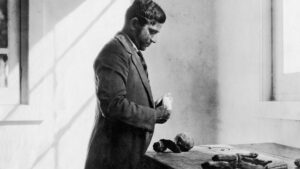Note4Students
From UPSC perspective, the following things are important :
Prelims level: Pandurang Khankhoje
Mains level: Ghadr party

Lok Sabha Speaker, who is currently in Canada for the 65th Commonwealth Parliamentary Conference, will travel to Mexico where he will unveil statues of Swami Vivekananda and Maharashtra-born freedom fighter and agriculturalist Pandurang Khankhoje.
Who was Pandurang Khankhoje (1883-1967)?
- Born in Wardha, Maharashtra, in the late 19th century, Pandurang Khankhoje came in contact with other revolutionaries early on.
- As a student, Khankhoje was an ardent admirer of the French Revolution and of the American War of Independence.
- Closer to home, the Hindu reformer Swami Dayanand and his Arya Samaj movement, which called for a spirit of reform and social change, became the hero to a young student group led by Khankhoje.
Revolutionary activities abroad
- Khankhoje decided to go abroad for further training in revolutionary methods and militaristic strategy.
- At this time, the British government’s suspicions of him were also growing due to his anti-government activities.
- Before leaving, he visited Bal Gangadhar Tilak, by whom he was inspired.
- Tilak advised him to go to Japan, which was itself a strong, anti-West Asian imperialistic force then.
- After spending time with nationalists from Japan and China, Khankhoje eventually moved to the US, where he enrolled in college as a student of agriculture.
Participation in the Indian independence movement
- Khankhoje was one of the founding members of the Ghadar Party, established by Indians living abroad in 1914, mostly belonging to Punjab.
- Its aim was to lead a revolutionary fight against the British in India.
- While in the US, Khankhoje met Lala Har Dayal, an Indian intellectual teaching at Stanford University.
- Har Dayal had begun a propaganda campaign, publishing a newspaper that featured patriotic songs and articles in the vernacular languages of India.
- This was the seed from which the Ghadar Party would emerge.
How did Khankhoje reach Mexico?
- At the military academy, Khankhoje met many people from Mexico.
- The Mexican Revolution of 1910 had led to the overthrow of the dictatorial regime, and this inspired Khankhoje.
- He also reached out to Indians working on farms in the US with the aim of discussing the idea of Indian independence with them.
- Along with the Indian workers, militant action was planned by Khankhoje in India, but the outbreak of the First World War halted these plans.
- He then reached out to Bhikaji Cama in Paris, and met with Vladimir Lenin in Russia among other leaders, seeking support for the Indian cause.
Association with Mexico
- As he was facing possible deportation from Europe and could not go to India, he sought shelter in Mexico.
- Soon, in part due to his prior friendship with Mexican revolutionaries, he was appointed a professor at the National School of Agriculture in Chapingo, near Mexico City.
- He researched corn, wheat, pulses and rubber, developing frost and drought-resistant varieties, and was part of efforts to bring in the Green Revolution in Mexico.
- Later on, the American agronomist Dr Norman Borlaug, called the Father of the Green Revolution in India, brought the Mexican wheat variety to Punjab.
- Khankhoje was revered as an agricultural scientist in Mexico.
Return to India
- Both Pandurang and Jean returned to India after 1947.
- His application for visa was initially rejected by the Indian government due to the ban by the British Indian Government, but was eventually overturned.
- He settled in Nagpur and subsequently embarked on a political career.
- Pandurang Khankhoje died on 22 January 1967.
Back2Basics: Ghadar PartyFounder: Sohan Singh Bhakna, 15 July 1913
|
Get an IAS/IPS ranker as your 1: 1 personal mentor for UPSC 2024
